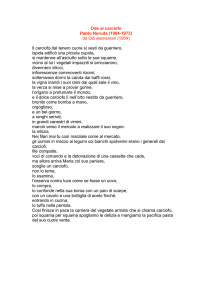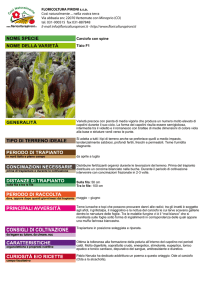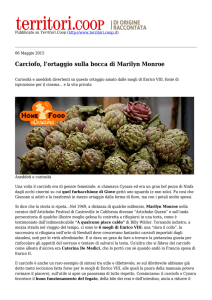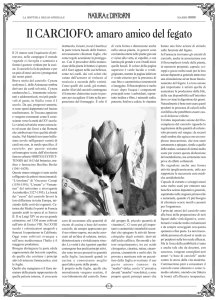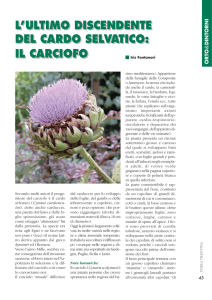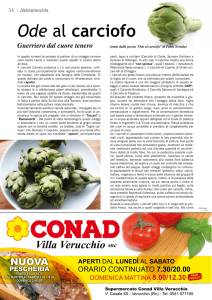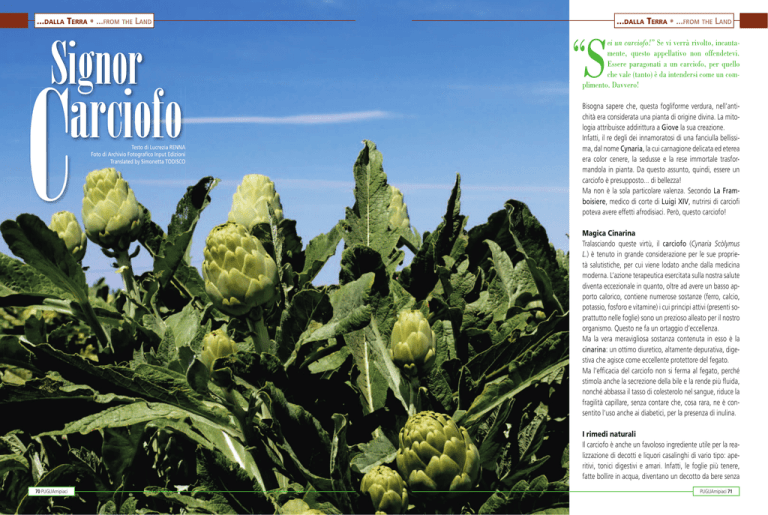
...dalla Terra • ...from the Land
Signor
C
arciofo
Testo di Lucrezia RENNA
Foto di Archivio Fotografico Input Edizioni
Translated by Simonetta TODISCO
“S
...dalla Terra • ...from the Land
ei un carciofo!” Se vi verrà rivolto, incautamente, questo appellativo non offendetevi.
Essere paragonati a un carciofo, per quello
che vale (tanto) è da intendersi come un complimento. Davvero!
Bisogna sapere che, questa fogliforme verdura, nell’antichità era considerata una pianta di origine divina. La mitologia attribuisce addirittura a Giove la sua creazione.
Infatti, il re degli dei innamoratosi di una fanciulla bellissima, dal nome Cynaria, la cui carnagione delicata ed eterea
era color cenere, la sedusse e la rese immortale trasformandola in pianta. Da questo assunto, quindi, essere un
carciofo è presupposto... di bellezza!
Ma non è la sola particolare valenza. Secondo La Framboisiere, medico di corte di Luigi XIV, nutrirsi di carciofi
poteva avere effetti afrodisiaci. Però, questo carciofo!
Magica Cinarina
Tralasciando queste virtù, il carciofo (Cynaria Scòlymus
L.) è tenuto in grande considerazione per le sue proprietà salutistiche, per cui viene lodato anche dalla medicina
moderna. L’azione terapeutica esercitata sulla nostra salute
diventa eccezionale in quanto, oltre ad avere un basso apporto calorico, contiene numerose sostanze (ferro, calcio,
potassio, fosforo e vitamine) i cui principi attivi (presenti soprattutto nelle foglie) sono un prezioso alleato per il nostro
organismo. Questo ne fa un ortaggio d’eccellenza.
Ma la vera meravigliosa sostanza contenuta in esso è la
cinarina: un ottimo diuretico, altamente depurativa, digestiva che agisce come eccellente protettore del fegato.
Ma l’efficacia del carciofo non si ferma al fegato, perché
stimola anche la secrezione della bile e la rende più fluida,
nonché abbassa il tasso di colesterolo nel sangue, riduce la
fragilità capillare, senza contare che, cosa rara, ne è consentito l’uso anche ai diabetici, per la presenza di inulina.
I rimedi naturali
Il carciofo è anche un favoloso ingrediente utile per la realizzazione di decotti e liquori casalinghi di vario tipo: aperitivi, tonici digestivi e amari. Infatti, le foglie più tenere,
fatte bollire in acqua, diventano un decotto da bere senza
70 PUGLIAmipiaci
PUGLIAmipiaci 71
...dalla Terra • ...from the Land
...dalla Terra • ...from the Land
zucchero prima dei pasti principali, proprio per combattere
i disturbi epatici. Inoltre, rischiara la pelle, ridona l’appetito ed è un ottimo stimolante
per i reni. Le radici, così come
le foglie, in decotto (30 gr. in
1 l d’acqua), aiutano ad alleviare i dolori derivanti da gotta ed artrite, ma la terapia va
seguita per 2/3 settimane. Il
carciofo, insomma, è un vero
toccasana.
Il carciofo
oltre ad avere
un basso apporto
calorico, contiene
numerose sostanze
i cui principi attivi
(presenti soprattutto nelle foglie) sono
un prezioso alleato
per il nostro
organismo.
72 PUGLIAmipiaci
Carciofi di Puglia
Il carciofo si mangiava comunemente sin dai tempi dei Greci e degli Egizi, che addirittura
lo consideravano un “dono del sole”. Le prime descrizioni
risalgono allo storico greco Teofrasto che, probabilmente,
faceva riferimento al carciofo selvatico. Continuò ad essere
apprezzato anche dai romani, come attestano alcuni scritti
di Columella e Plinio il Vecchio. Attualmente l’Italia è
il primo paese produttore di carciofi, con una forte concentrazione delle coltivazioni nell’Italia centro-meridionale.
La pianta, infatti, predilige un clima costantemente dolce,
mite, piuttosto asciutto, ama
i suoli profondi, silicei, argillosi, calcarei e ricchi di sostanze
organiche tendenti al neutro.
La Puglia è una delle sue regioni d’elezione. Le prime
notizie della presenza del
carciofo nella nostra regione
risalgono al 1736. Nei primi
anni del ‘900 il carciofo era
coltivato su piccole superfici e
già nel 1949 era presente su
circa 958 ha. Negli ultimi cinquant’anni la superficie di terreni dedicati alla coltivazione
di questa pianta è aumentata
notevolmente ed il carciofo è diventato uno degli emblemi
del made in Puglia: Foggia è la provincia con la maggiore
produzione (56% della produzione totale pugliese), a seguire Brindisi, Bari, Taranto e Lecce. Anche per questo motivo la ristorazione regionale ha messo il carciofo al centro
dei suoi menu. Il suo sapore piacevolmente amarognolo,
spiccato, ma poco invadente sugli altri ingredienti, lo rende
ideale per numerose preparazioni culinarie, per la gioia dei
ristoratori pugliesi e dei tanti immancabili buongustai.
PUGLIAmipiaci 73
...dalla Terra • ...from the Land
...dalla Terra • ...from the Land
Mister Artichoke
Originario dell’Africa del Nord il carciofo, dall’arabo alkharshûf, si diffuse in Europa nel 1400 e venne subito esaltato per
le sue proprietà medicinali. È una pianta erbacea perenne,
alta fino a 1,5 metri. Il fusto è robusto, cilindrico e carnoso,
striato longitudinalmente. Le foglie sono grandi, oblungolanceolate di colore verde-grigiastra, le cui estremità sono più
o meno spinose a seconda della varietà. I fiori sono riuniti in
un “capolino” di forma sferoidale, conica o cilindrica, di 5-15
cm di diametro, con un ricettacolo carnoso e concavo in cui
sono inseriti i fiori, tutti con corolla tubulosa di colore azzurroviolacea a formare un “pappo” setoloso. Sulla periferia del
ricettacolo si sviluppano delle squame carnose, verdi o violacee, con o senza spina apicale, comunemente chiamate “foglie del carciofo”: più consistenti e fibrose all’esterno, mentre
quelle interne sono molto tenere e costituiscono la parte meglio commestibile, detta anche “cuore”. La classificazione viene fatta secondo diversi criteri. Vanno distinte: varietà spinose
(che presentano una spina all’estremità delle brattee), inermi
(senza alcuna spina); in base al colore “violette” o “verdi”; in
base alla stagionalità, ovvero, autunnali o primaverili.
Artichoke takes origin from North Africa. Its scientific name is Cynaria
Scòlymus L, in arabic language alkharshûf, it arrived in Europe in 1400 and
soon was exalted for its medicinal properties. It is a perennial herbaceous
plant, up to 1,5 mt tall. Its stern is vigorous cylindrical and fleshy, with
longitudinal striations. The leaves are large, oblong, green-grey coloured,
with thorny extremities according to the variety. Its flowers are united in a
cylindrical “capolino” (round shaped of 5-15 cm diam) containing a fleshy
receptacle where flowers are inserted with their blue-violet coloured corolla. Around the receptacle develope green or violet fleshy scales, commonly
called “leaves” of artichoke: they are externally harder than those internal,
which are tender and more edible (these are called “heart” of artichoke)
and the terminal of them could have a stings or not. The classification of
artichokes depends on various factors: “thorny” variety (the leaves end with
a thorn); “unarmed” (without thorns); “violet variety” and “green variety”
on the base of their colour; on the base of the season we have “spring
variety” and autumn variety”.
74 PUGLIAmipiaci
“You’re an artichoke!” If someone will imprudently give you this
name, please don’t take umbrage at it. Being compared to an
artichoke, is a compliment... if you consider the big value it has
today. Really! People should know that this leaf-shaped vegetable was considered a divine plant in the antiquity. Mythology
attributes its creation to Jupiter. It narrates that the King of
Gods fell in love with a beautiful young girl called Cynaria, with
a delicate cinder-coloured complexion. Jupiter seduced her and
made her immortal by transforming her in a plant. For this reason, being called an “artichoke” is synonym of... beauty! But
there’s more than this: according to La Framboisiere, who was
doctor at the court of King Louis XIV, to feed with artichokes
could have aphrodisiac effects. What a portent this artichoke!
Magical cinarina
Let’s skip for a moment these virtues. Artichoke (Cynaria Scòlymus L.) is praised by contemporary medicine because of its healthy properties. Its therapeutic action on our health becomes
evident if we consider that artichoke has a low caloric brought
in, but contemporarily contains a lot of positive substances: iron,
calcium, potassium, phosphorous and vitamins.
Its active agents, contained above all in the leaves, are a precious
ally for our wellness. For these reasons artichoke is an excellent
vegetable. The most prodigious substance provided by artichoke
is cinarina: a good diuretic, highly depurative and digestive, it
acts as an excellent defender of liver.
The efficacy of artichoke enlarges to other organs: it stimulates
the secretion of bile by rendering it more fluid; it lowers the
cholesterol in blood, strengthens arteries and is recommended
to diabetics, because of the presence of inulin among is basical
factors.
The Romans continued appreciating it, as we can find in some
writings by Columella and Plinio the Old.
At present time Italy is the first producer of artichokes, specially
in the middle and south of the country. The plant, in fact, prefers
a mild climate, preferably dry, likes deep flinty, clayey, calcareous
grounds, rich of neutral organic substances.
Apulia is one of its favourite places. Probably artichoke appeared
in this region since 1736. In the first years of ‘900 the cultivation
of artichoke occupied little squares of land, but yet in 1949, it
occupied 958 ha. In the last 50 years the area dedicated to this
vegetable has increased exponentially and artichoke has become a symbol of “made in Apulia”: Foggia holds the supremacy
among the five provinces with 56% of the total apulian production. Brindisi is at the second place, followed by Bari, Taranto
and Lecce.
For this reason we can find artichoke as a protagonist of the
traditional menu.
Its flavour is agreeably bitterish, distinct but not intrusive above
other ingredients. It is ideal for many preparations, very apreciated by restaurant operators and also by gourmets.
Freschezza. Volete sapere come fare per riconoscere la freschezza di un carciofo? Semplice.
Afferrateli con indice e pollice e premete; se il
carciofo è duro e compatto è fresco, se tende ad
appiattirsi, invece, non lo è. Un carciofo fresco
deve avere le punte ancora ben chiuse e, se il
gambo ha ancore delle foglie attaccate, queste
non devono essere appassite, ma al contrario
ben fresche.
Freshness. Would you like to know how to taste freshness of an artichoke? Easy! Hold and press it between
thumb and forefinger; if it is fresh you will find it tough
and compact, on the contrary if it squeezes easily it is
not fresh. Another test of freshness can be made by
observing its tips: if fresh they are closed; besides if the
stern has still leaves they must be fresh and not faded.
Natural remedies
Artichoke is also a fabulous ingredient of decoctions and many
homemade liqueurs: aperitifs, tonics, digestives and bitters. In
fact, the youngest leaves, boiled in water, become an extraordinary decoction that has to be drunk without sugar before meals
to prevent liver troubles.
Moreover, it clear up the skin, stimulates appetite and reinvigorates kidneys. Its roots, like its leaves, in decoction (30 gr. in
1 litre of water), help to ease troubles deriving from gout and
arthritis, if the therapy is followed for 2/3 weeks. In short, artichoke is an authentic panacea.
Artichokes of Apulia
In the antiquity artichoke was well known by the Greeks and
Egyptians, they ate it regularly, considering it like a “gift of the
Sun”. The most ancient description of it date back to the Greek
historian Teofrasto, who probably refers to wild artichoke.
PUGLIAmipiaci 75

